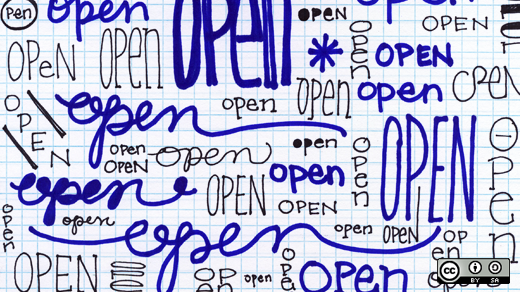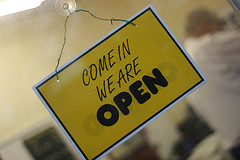Well, I’m glad to say I think I’m making progress on my quest to more fully understand the notion of open and the triad of open-related courses that I’m weaving my way through seems to be shaping up nicely as I undertake my ‘Grand Tour’.
In my previous post, I thought about what openness means to me because, like digital literacy, ‘open’ is another one of those unhelpful ambiguous terms: used across contexts, meaning different things to different people. For me, I said openness was a way of being, a way of being a learner on the open web. I’d heard openness being described as a way of being before but I was unable to attribute the phrase or elaborate on what was meant. Fortunately, my readings quickly remedied this and I became acquainted with Cameron Neylon who draws attention to ‘being open‘; that is, being open as opposed to simply making open resources. He goes on to say that being open is about embracing a particular form of humility; it’s about embracing the idea that as a creator despite being supremely knowledgeable about your work, you can’t predict the use and application to which your work might be put. Further still, it’s about accepting that by working openly vital contributions and insights may come from unexpected sources. I think being ‘open to unexpected uses’ is something that the field of open research is grappling with as it considers the ethics bound up in such a position. Well, that’s what I’m picking up as I dabble in the Open Research MOOC from the OER Research Hub.

Meanwhile, over in Stanford’s Open Knowledge MOOC I was reminded that open, or more specifically ‘open content’ is the
attempt to appropriately adapt the logic of “open source” software to the non-software world of cultural and scientific artifacts like music, literature, and image […and higher education?] (Wiley, 2009),
which links nicely back to Cameron Neylon’s piece where he explains that the Open Source community is not just amenable to encouraging the unlimited use of resources thus maximizing their potential use (and their unexpected use), but they’ve also gone further in developing mechanisms that support the ability of anyone to contribute to projects. He explains, and this is where it gets interesting,
you don’t just throw the code over the fence and expect a project to magically form around it, you invest in and support community creation with the aim of creating a sustainable project. Successful open source projects put community building, outreach, both reaching contributors and encouraging them, at their center.
This is where it gets interesting because that’s what seems to be happening over in Connected Courses. Here, the pre-course weeks were dedicated to ‘Blog Talk’ and the nuts and bolts of getting participants’ blog sites syndicated and connected to the course hub, such are the practicalities of this distributed mode of delivery. However, this group of educators,
a collaborative network of faculty in higher education developing online, open courses that embody the principles of connected learning and the values of the open web,
are keen to dig deeper and support others in the whole area of open/connected learning and the tools and infrastructure that’s required to run these types of courses. Consequently, they’re not only modelling this stuff, but they’ve made available a series of resources and are willing to support anyone willing to have a go at hosting their own site and developing their own course, or learning community. So that’s just what I’ve been prompted to do. I’ve signed up with Reclaim Hosting and I’m now, as Howard Rheingold puts it, well and truly ‘Under The Hood: Where Technology, Pedagogy, and Power Meet‘.

I’ve posted links to the resources below and you can view my Storify “Creating a Learning Environment with Open Source Tools” to see how helpful these folks are and what it’s like working in the open and building a community. Incidentally, and just to underscore the reason why going down the self-hosted route and developing your own webs skills is a good idea, I actually wanted to embedded my Storify in this post, like I’ve done before, but discovered that WordPress.com and Storify no longer have the same arrangement, so I’m at their mercy in terms of what I can do and how much control I have on such platforms.
Links to resources:
Connected Courses Documentation Wiki
http://docs.connectedcourses.net/
Under The Hood: Where Technology, Pedagogy, and Power Meet – Howard Rheingold
http://connectedcourses.tumblr.com/post/97092652075/under-the-hood-where-technology-pedagogy-and-power
Building with Howard: How to Create a Learning Environment with Open Source Tools Pt 1
http://media.umw.edu/podcasts/reclaim-hosting/building-with-howard-how-to-create-a-learning-envi
Building with Howard: How to Create a Learning Environment with Open Source Tools Pt 2
http://media.umw.edu/podcasts/reclaim-hosting/building-with-howard-how-to-create-a-learning-en-2
Building with Howard: How to Create a Learning Environment with Open Source Tools Pt 3
http://media.umw.edu/podcasts/reclaim-hosting/reclaim_3mp4
Building Connected Courses: Feed WordPress 101
http://cogdogblog.com/2014/07/14/feed-wordpress-101/
Feed WordPress 101: The Basics
http://cogdogblog.com/2014/07/14/feed-wordpress-101-the-basics/
Feed WordPress 101: Installing and Setting Up The Machine
http://cogdogblog.com/2014/07/16/feedwordpress-setting-up-machine/
Feed WordPress 101: Feeding The Machine
http://cogdogblog.com/2014/07/17/feeding-the-machine/
Feed WordPress 101: Some Feed Magic
http://cogdogblog.com/2014/07/24/wordpress-101-feed-magic/
Feed WordPress 101: A Few More Tricks For Your Site
http://cogdogblog.com/2014/07/28/feed-wordpress-101-more-tricks/
References:
Neylon, C. (2013) Open is a state of mind. Science in the Open. Available at: http://cameronneylon.net/blog/open-is-a-state-of-mind/?utm_source=feedburner&utm_medium=feed&utm_campaign=Feed%3A+ScienceInTheOpen+%28Science+in+the+open%29
Wiley, D. (2009) Defining “open”. Iterating toward openness. Available at: http://opencontent.org/blog/archives/1123
Image source:
by Opensourceway https://www.flickr.com/photos/opensourceway/5009661706/sizes/o/

This work is licensed under a Creative Commons Attribution-ShareAlike 4.0 International License.


